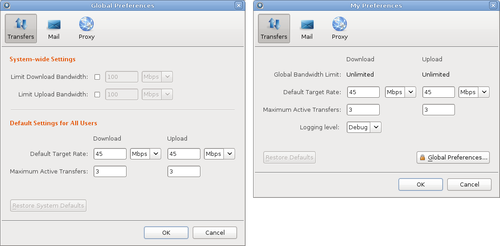Managing Transfers
The HST Server GUI enables you to start, stop, and reorder transfers, as well as adjust transfer rates and policies and configure transfer preferences.
The Transfers Panel: Start, Stop, and Reorder Transfers
Once the transfer starts, a progress bar appears in the Transfers panel. You can manage transfer behavior with the following actions:
- Click
 to start the selected transfer.
to start the selected transfer. - Click
 to stop the selected transfer.
to stop the selected transfer. - Click
 to delete the selected transfer.
to delete the selected transfer. - If you have multiple ongoing transfers, use the
 and
and  to change the selected transfer's priority. The # field indicates the transfer's order
in the queue.
to change the selected transfer's priority. The # field indicates the transfer's order
in the queue.
The Details View: Adjust Transfer Rates and Policies of Active Transfers
The Details button provides additional oversight and control (if you have permission) over transfers. Select a transfer session from the Transfers panel and click Details to view details and adjust settings.

The Details display shows the following information:

| Item | Name | Description |
|---|---|---|
| A | Details (tab) | Transfer details, including status (rate and ETA) and statistics (session size, files transferred vs. total files to be transferred, average speed, time elapsed, RTT delay and average loss in percent). |
| B | Files (tab) | All files being transferred in this session, along with each files' size and transfer progress. |
| C | Transfer controls | Set the FASP transfer policy and transfer rate, if allowed.
Important: If --policy is not set, ascp uses
the server-side policy setting (fair by default). |
| D | Transfer Monitor | The transfer graph. Use the sliders on the vertical axis to adjust the transfer rate up or down (if allowed). |
Configuring Transfer Preferences
If you have administrator privileges, you can set the target transfer rate for all users from the Global Preferences dialog. As an individual user, you can override the global settings from My Preferences.
To update these settings, go to Tools > Global Preferences or Tools > Preferences. You can also open My Preferences from the Preferences button in the upper-right corner of the application's main window; from there you can also reach the Global Preferences dialog by clicking Global Preferences.

The following options are available under the Transfers tab:
| Item | Description |
|---|---|
| Global Bandwidth Limits | The aggregated bandwidth cap for all FASP transfers on this computer. For more advanced bandwidth settings, see Bandwidth Configuration. (Set by administrators only.) |
| Default Target Rate | The initial download and upload rates for all transfers. |
| Maximum Active Transfers | The maximum number of concurrent upload transfers and download transfers. |
For information about Email settings, see Configuring Transfer Notifications.